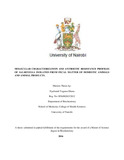| dc.contributor.author | Nyabundi, Vugutsa D | |
| dc.date.accessioned | 2016-11-15T09:36:55Z | |
| dc.date.available | 2016-11-15T09:36:55Z | |
| dc.date.issued | 2016 | |
| dc.identifier.uri | http://hdl.handle.net/11295/97275 | |
| dc.description.abstract | Salmonella species are among the most genetically diverse and a common cause of food borne diseases worldwide. The species is associated with important losses in animal produce and it has significant public health implications due to its role as a food borne and zoonotic pathogen. The situation is aggravated by the ever increasing number of antimicrobial resistant strains due to the use of antimicrobials in agriculture at sub therapeutic doses for growth promotion Salmonella is transmitted through the fecal oral route with domestic animals such as chicken, pigs and cattle acting as major reservoirs of human transmission. Despite being of significant public concern limited data is available regarding the prevalence and antimicrobial susceptibility patterns of circulating serovars for non typhoidal Salmonella (NTS) isolated from domestic animals and animal products in Kenya. This project therefore was conducted to determine the prevalence of Salmonella in domestic animals, characterize the circulating Salmonella serovars and their evolutionary relationships as well as determine patterns of drug resistance.
A cross sectional study was conducted and a total of 740 samples fecal samples of cows (n=150), pigs (n=182), chicken( n=191) and chicken eggs (n=217) were collected from various markets and abattoirs in Nairobi, Mombasa, Machakos, Meru, Thika and Kakamega counties from November 2013-October 2014. The samples were pre enriched in buffered peptone water or nutrient broth followed by selective enrichment using selenite cysteine broth. Isolation was done by inoculating the selectively enriched sample on XLD agar, followed by confirmation of presumptive colonies biochemically using API 20E strips and PCR using 16s rRNA and finally phylogenetic analysis was carried out using the Bayesian method. The sensitivity to commonly used antimicrobial drugs was also carried out using the Kirby disk diffusion method.
Out of the samples collected, the prevalence of Salmonella by PCR was 3.8%, 3.6%, 5.9% and 2.6 % for pigs, chicken, eggs and cows respectively. Two serovars S. Typhimurium and S. Enteritidis which are responsible for most Salmonella associated outbreaks in humans were isolated with S. Typhimurium (18/21 =85%) being more common. The two serovars formed distinct clades on the phylogenetic tree. Antimicrobial resistance was detected was detected in 40% of the isolates with 20% of the isolates being resistant to more than one drug. The highest resistance was observed against sulphamethoxazole at 30% followed by ampicillin 20% while 10% of the isolates were resistant to cotrimoxazole and tetracycline.
These findings indicate that domestic animals act as reservoirs of Salmonella and since contamination can occur at multiple points in the food chain, it is important to conduct regular surveillance amongst domestic animals and animal products. This will help provide appropriate risk management options to manage transmission to humans as well as reduce the economic losses to the farmers. The resistance to sulphamethoxazole may be an indicator that the drug is commonly used in animal husbandry thus creating selection pressure for Salmonella to develop resistance. There also needs to be concerted efforts towards raising awareness among the communities and health care workers about the consequences of inappropriate use and emergence of antimicrobial resistance | en_US |
| dc.language.iso | en | en_US |
| dc.publisher | University of Nairobi | en_US |
| dc.rights | Attribution-NonCommercial-NoDerivs 3.0 United States | * |
| dc.rights.uri | http://creativecommons.org/licenses/by-nc-nd/3.0/us/ | * |
| dc.subject | Domestic Animals and Animal Products. | en_US |
| dc.title | Molecular Characterization and Antibiotic Resistance Profiles of Salmonella Isolated From Fecal Matter of Domestic Animals and Animal Products. | en_US |
| dc.type | Thesis | en_US |
| dc.description.department | a
Department of Psychiatry, University of Nairobi, ; bDepartment of Mental Health, School of Medicine,
Moi University, Eldoret, Kenya | |



